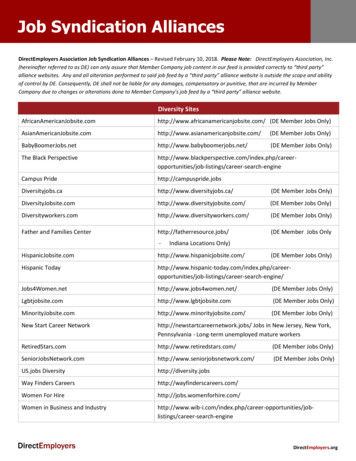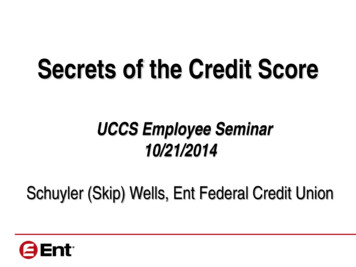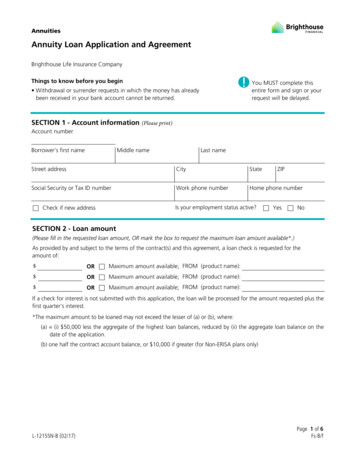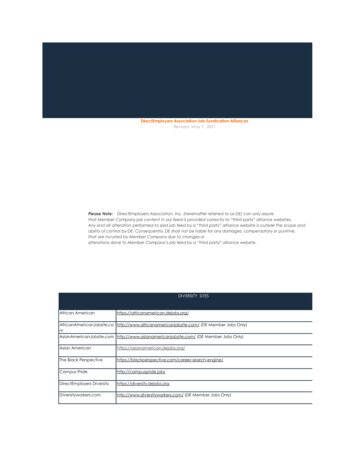
Transcription
American Economic Review: Papers & Proceedings 100 (May 2010): 57–61http://www.aeaweb.org/articles.php?doi 10.1257/aer.100.2.57Loan Syndication and Credit CyclesBy Victoria Ivashina and David Scharfstein*Cyclicality in the supply of business credithas been the focus of a considerable amount ofresearch. This cyclicality can stem from shocksto borrowers’ collateral, which affect firms’ability to raise capital if agency and informationproblems are significant (Ben S. Bernanke andMark Gertler 1989). Or it can stem from shocksto bank capital, which affect the supply of bankloans if agency and information problems limitthe ability of banks to raise additional capital(Bernanke 1983). Both of these channels mayhave been at work during the financial crisis thatstarted in 2007. Ran Duchin, Oguzhan Ozbas,and Berk A. Sensoy (2010) show that firms withmore collateral were better able to withstand thecontraction in credit, and Victoria Ivashina andDavid Scharfstein (2010) show that reductionsin bank capital had an adverse effect on lending.In this paper, we examine cyclicality in thesupply of credit in the context of modern formsof banking, often referred to as the “originateto-distribute” model. In particular, we areinterested in the role of syndicated lending. Intraditional bank lending—the focus of mostmodels of banking—banks originate and holdloans on their balance sheets. This exposesbanks to risk but provides them with strongincentives to screen and monitor borrowers(Douglas W. Diamond 1984). Over the last 20years, however, the development and growth ofthe syndicated loan market has enabled a bankto originate a loan but retain only a fraction ofit. On average, the originating bank (or “leadbank”) retains about a third of each syndicatedloan and sells the remaining share to a syndicateof investors, which includes banks and institutional investors such as pension funds, mutualfunds, hedge funds, and sponsors of structuredproducts.1 In addition to receiving interest on itsshare of the loan, the lead bank also receives afee for arranging the syndication.The advantage of syndicated lending is that itenables originating banks to share risk across thesyndicate. Such risk sharing is valuable if banksare themselves financed in an imperfect capitalmarket and adverse shocks require them to raisecostly external capital (Kenneth A. Froot andJeremy C. Stein 1998). As shown by Ivashina(2009), banks weigh this diversification benefitagainst the reduced incentive they have to screencredit risk and monitor borrower behavior.The process of syndication leads to an expansion of credit because it enables banks to sharerisk, which lowers their risk threshold for originating a loan. It also expands credit by making itpossible for institutional investors to participatedirectly in funding the types of loans that banksoriginate, rather than indirectly by funding thebank. The value of this sort of financing is consistent with the model of financial intermediation developed by Bengt Holmstrom and JeanTirole (1998).While loan syndication arguably expandscredit supply, the question we address here iswhether it increases the cyclicality of credit supply. Loan syndication can amplify credit cycles if,in response to an economic downturn, lead banksare required to hold larger shares of the loans theyoriginate. If banks are financially constrained,then this larger share reduces the amount of loansthey are willing to originate during a downturn.By contrast, if the lead share falls during a downturn, then this increase in risk sharing could actually dampen credit cyclicality.While this is ultimately an empirical question,one might expect the lead share to rise duringa downturn because of (i) shocks to borrowers,(ii) shocks to bank capital, and (iii) variation ininvestor sentiment.* Ivashina: Harvard Business School, Baker Library233, Boston, MA 02114 (e-mail: vivashina@hbs.edu);Scharfstein: Harvard Business School, Baker Library 239,Boston, MA 02114 (e-mail: dscharfstein@hbs.edu). We aregrateful to our discussant, Viral Acharya, and AEA AnnualMeeting participants for helpful comments.1These collateralized loan obligations typically pooland tranche speculative grade debt. They started being usedaround 2003 and at their peak in 2007 accounted for 60percent of syndicated loan purchases.57
58AEA PAPERS AND PROCEEDINGSShocks to borrowers.—Bernanke and Gertler(1989) suggest that during a downturn borrowercollateral values are impaired and risk increases,which exacerbates asymmetric informationand incentive problems. This, in turn, increasesscreening and monitoring costs, and thus theshare the lead bank has to hold in order to havethe incentive to monitor and screen. This is alsoconsistent with the model of financial intermediation developed by Holmstrom and Tirole (1997).Shocks to bank capital.—A downturn may beassociated with an adverse shock to bank capital.If participant banks are more adversely affected,this will result in an increase in the lead share.Even if participants are no more likely to beadversely affected than leads, there could be anincrease in the cross-sectional variation of bankcapital during downturns. The more adverselyaffected banks will require higher returns forusing their capital to participate in the loan syndication. This would take the form of higher interest spreads on the loan, and lower fees to the leadbank. Rather than offer higher spreads to syndicate participants and take a lower fee, the leadbank may prefer to hold a larger share of the loan.Shocks to investor sentiment.—AndreiShleifer and Robert W. Vishny (2010) argue thatthere may be periods in which investors overvalue the loans that banks originate for distribution, whether through securitizations or loanparticipations. In their model, banks are willingto originate loans during episodes of overvaluation as long as they can collect large enoughupfront fees and do not need to retain too largea share of the loans. It follows from their framework, though they do not model it, that the leadbank in a loan syndication will sell as much ofthe loan as possible to limit how much it retainsof the overvalued loan. Indeed, Ivashina andZheng Sun (2008) show that during the 2004–2007 credit boom the fall in loan spreads wasat least partially caused by the institutionalinvestors’ positive sentiment. When this positive sentiment ends, as it arguably does duringa downturn, the lead share should rise as banksno longer sell overvalued loans.I. The Cyclicality of Lead ShareTo examine the cyclicality of the lead share,we analyze a sample of US corporate syndicatedloans from the Reuters DealScan database cov-MAY 2010ering the period January 1990–June 2009. Weexclude financials and constrain the sample toloans for which the lead bank’s share is available.2 The lead share is reported in roughly athird of the cases; potential reporting biases areextensively discussed in Ivashina (2009) and areunlikely to affect our analysis.The unit of observation in our sample is thesyndicated loan (as opposed to a loan facility).3There are 5,436 such syndicated loans withinformation available on the lead share. Theaverage loan size is 408 million (deflated to2009). The average lead share across the sampleis 29 percent, and there are an average 9 participants in a syndicate.We first document a strong negative relationship between aggregate syndicated loan volumeand lead share. This is depicted in Figure 1.The lead share is the average fraction of syndicated loans retained on the lead bank’s balancesheet. The lead share is the average fractionof syndicated loans retained on the lead banksbalance sheet. The correlation between leadshare and lending volume is 0.67; as lendingvolume falls, the lead share rises. After seasonally adjusting lending volume, the correlationis 0.64. The correlation is 0.50 even if oneexcludes 1990–1994, the early period of thesyndicated loan market during which the market grew rapidly as the lead share fell. Whileone cannot claim that the increase in lead sharereduces lending volume, there is a clear association between the two.Figure 2 reveals a connection between the leadshare and credit conditions. The figure plots leadshare and a measure of credit availability basedon the Federal Reserve Senior Loan OfficerOpinion Survey on Bank Lending Practices. Thissurvey measure is the net percentage of domestic bank respondents who report tightening2There are several roles that can be assigned to lendersin the syndicate. We define the lead bank as the member ofthe syndicate that is designated as the administrative agent,since this is the bank that is responsible for traditional bankduties including due diligence, payment management, andmonitoring of the loan. If the database does not designatean administrative agent, then a lender that is designated asagent, arranger, bookrunner, lead arranger, lead bank, orlead manager is defined as a lead bank.3Large loans are typically structured in multiple facilities. All facilities are covered by the same loan agreement;however, they may have different maturity or drawdownterms.
Loan Syndication and Credit CyclesVOL. 100 NO. 25944940Lead share (percent)740Total loan issuance (Billion USD, secondary 96ar-97Mar-9M 8ar-9M 9ar-0M 0ar-0M 1ar-0M 2ar-0M 3ar-0M 4ar-0M 5ar-0M 6ar-0M 7ar-0M 8ar-0934042854903322640036Billiion USDPercent%40Figure 1—Loan Share Retained by the Originating Bank and Loan Issuance VolumeNotes: The graph is compiled from DealScan database of loan originations and correspondsto US, nonfinancial syndicated loans. Lead share is a three-month rolling window average(equally weighted). Loan issuance is the total issuance in a given quarter. Shaded areas indicateUS economic recessions as defined by NBER.44100Lead share (percent)Net percent of respondants tightening standards for C&I loans75322528024–2520–50r-9r-9ApApAp 1r-9Ap 2r-93Apr-94Apr-9Ap 5r-9Ap 6r-9Ap 7r-9Ap 8r-9Ap 9r-0Ap 0r-0Ap 1r-0Ap 2r-0Ap 3r-0Ap 4r-0Ap 5r-0Ap 6r-0Ap 7r-0Ap 8r-0950036Billiion USDPercent40Figure 2—Loan Share Retained by the Originating Bank and Credit CycleNotes: The graph is compiled from DealScan database of loan originations and corresponds toUS, nonfinancial syndicated loans. Data on credit standard tightening comes from the FederalReserve Senior Loan Officer Opinion Survey on Bank Lending Practices. The series corresponds to the net percentage of domestic respondents tightening standard for commercial andindustrial (C&I) loans to large and medium sized firms. Lead share is a three-month rollingwindow average (equally weighted). Horizontal axis is modified to match the timing of the survey. Shaded areas indicate US economic recessions as defined by NBER.standards for all commercial and industrial(C&I) loans to large and medium-sized firms(including both syndicated and nonsyndicatedloans). The figure indicates that there is a positive relationship between the credit tighteningand lead share. This is particularly true as credittightened during the banking crisis of 1990–91,the credit tightening brought on by the failureof Long-Term Capital Management, and themost recent financial crisis. The same cannot besaid of the credit tightening that occurred in therecession of 2001.The basic patterns in Figure 2 are also apparent in the loan level regressions reported inTable 1. Since lead share has been shown tobe related to firm and loan characteristics, weinclude controls for firm size, credit rating, loansize, and loan maturity (Ivashina 2009). Thesecontrols all have the predicted sign. The coefficient of the credit tightening variable is positiveand statistically significant at the ten percentlevel. One can see that the coefficients are muchlarger and more statistically significant if weexclude the period around the 2001 recession.
60MAY 2010AEA PAPERS AND PROCEEDINGSTable 1—Loan Share Retained by the Originating Bank and Credit CycleLead shareCredit tighteninglog (loan amount)log (sales)Loan maturityObservationsR2Full sample1990–19990.01*[0.01] 6.26***[0.24] 1.12***[0.18] 0.64***[0.11]0.06**[0.02] 7.48***[0.37] 0.85***[0.32] 0.01] 5.24***[0.48] 1.92***[0.34] 1.38***[0.25]1,7780.51Notes: The dependent variable is share of the loan retained by the originating banks in percent.Each regression includes two-digit SIC industry, and credit ratings fixed effects. Robust standard errors are reported in brackets.*** Significant at the 1 percent level.** Significant at the 5 percent level.* Significant at the 10 percent level.An alternative explanation of the countercyclicality of the lead share is based on the countercyclicality of loan demand. Since loandemand falls during a recession, lead banksmay have enough capital to fund larger shares oftheir originations. In this view, we should haveobserved an increase in the lead share in all threerecessions in the sample. The fact that we do notsee an increase in the lead share during the 2001recession suggests that there is another factor atwork. Indeed, a key distinction between the 2001recession and the other recessions in the sampleis that the others were both associated with (orperhaps caused by) significant negative shocks tobank capital. By contrast, the 2001 recession wasassociated with the bursting of the tech bubble,which had little or no effect on bank capital.4 Thissuggests that shocks to financial capital underliethe relationship between lead share and creditconditions. In other words, shocks to borrowercollateral and risk are less important in explaining variation in the lead share.4Nonperforming loans as a fraction of tangible common equity and allowances for loan losses was 0.12 in2001 recession (0.10 in 1999) and 0.20 in 2007–2009 (0.5in 2006). Numbers correspond to the 15 largest US syndicated loan originators with Call Reports available. Theaverage Center for Research in Security Prices marketbeta excess return for the top four US originators (Bankof America, JPMorgan Chase, Citibank, Goldman Sachs)was five percent in annualized terms between March 2001and November 2001 (NBER recession) and 21 percentbetween December 2007 and December 2008.If shocks to capital primarily affect leadbanks, one would expect lead share to havefallen in financial crises. The fact that lead shareincreased during periods of reduced bank capitalsuggests that the shocks may have had a largereffect on the capital of syndicate participants. Ifthese investors lacked capital to hold new loanoriginations, it would have forced the lead bankto hold a larger share of the loan. As suggestedabove, it is also possible that the shocks did nothave a greater effect on the capital of syndicateparticipants but did increase the variation inbank capital, leading more capital constrainedparticipants to demand higher returns for theirparticipation. Rather than offer higher returnsto all participants, the lead bank may chooseinstead to offer lower returns to the syndicateand retain a larger share of the loan. This explanation would suggest that during periods whenthe average lead share is high, the average number of participants in the syndicate should below. Figure 3 plots these two series, which havea correlation of 0.93. This negative correlation may also be consistent with the existenceof variation in investor sentiment over the cycle,as there are fewer investors who overvalue theloan participation during a downturn and perhaps more who undervalue such participations.II. Final RemarksWe have argued that cyclical variation inthe demand for loan participations—whether
Loan Syndication and Credit CyclesVOL. 100 NO. 24418Lead share (percent)40Numbers of lenders (secondary axis)1592862432002arMM-9-9-9arMarMar-9M 3ar-9M 4ar-9M 5ar-9M 6ar-9M 7ar-9M 8ar-9M 9ar-0M 0ar-0M 1ar-0M 2ar-0M 3ar-0M 4ar-0M 5ar-0M 6ar-0M 7ar-0M 8ar-0932112036Billiion USDPercent61Figure 3. Loan Share Retained by the Originating Bank and Number of SyndicateParticipantsNotes: The graph is compiled from DealScan database of loan originations and corresponds toUS, nonfinancial syndicated loans. Lead share and number of lenders is a three-month rollingwindow average (equally weighted). Shaded areas indicate US economic recessions as definedby NBER.through shocks to bank capital or variationin investor sentiment—can help to explain variation in the lead share and thus also increasethe cyclicality of credit. One limitation of thisanalysis is that we have ignored the role of securitization in the syndication process. Beginningin 2004, sponsors of collateralized loan obligations (CLOs) became large buyers of speculative grade syndicated loans. This increase inloan demand was associated with an expansionof credit, particularly for leveraged buyouts,and a reduction in the share held by lead banks.As CLO demand evaporated in mid-2007 dueto concerns about all types of securitization,lead share increased. Although this is not theexplanation we have emphasized, it is consistentwith our general perspective since CLOs can bethought of as special purpose financial institutions that experienced large increases and thendecreases in their supply of capital. This wouldthen have an effect on lead share and the supplyof credit. This suggests that there are importantlinkages between securities markets and loansyndication. Further study of these interactionsis likely to be a fruitful area of research.REFERENCESBernanke, Ben, and Mark Gertler. 1989. “AgencyCosts, Net Worth, and Business Fluctuations.”American Economic Review, 79(1): 14–31.Diamond, Douglas W. 1984. “Financial Interme-diation and Delegated Monitoring.” Review ofEconomic Studies, 51(3): 393–414.Duchin, Ran, Oguzhan Ozbas, and Berk Sensoy. Forthcoming. “Costly External Finance, Cor-porate Investment, and the Subprime Mortgage Credit Crisis.” Journal of FinancialEconomics.Froot, Kenneth A., and Jeremy C. Stein. 1998.“Risk Management, Capital Budgeting, andCapital Structure Policy for Financial Institutions: An Integrated Approach.” Journal ofFinancial Economics, 47(1): 55–82.Holmstrom, Bengt, and Jean Tirole. 1997. “Financial Intermediation, Loanable Funds, and theReal Sector.” Quarterly Journal of Economics,112(3): 663–91.Ivashina, Victoria. 2009. “Asymmetric Information Effects on Loan Spreads.” Journal ofFinancial Economics, 92(2): 300–19.Ivashina, Victoria, and David Scharfstein. Forthcoming. “Bank Lending During the FinancialCrisis of 2008.” Journal of Financial Economics.Ivashina, Victoria, and Zheng Sun. 2008. “Institutional Demand Pressure and the Cost of Leveraged Loans.” Unpublished.Shleifer, Andrei, and Robert Vishny. Forthcoming. “Unstable Banking.” Journal of Financial Economics.
Figure 2—Loan Share Retained by the Originating Bank and Credit Cycle Notes: The graph is compiled from DealScan database of loan originations and corresponds to US, nonfinancial syndicated loans. Data on credit standard tightening comes from the Federal Reserve Senior Loan Officer Opinion Survey on Bank Lending Practices. The series corre-










